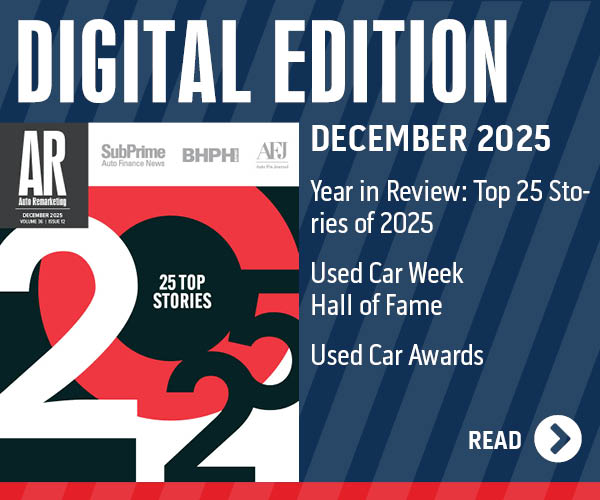COMMENTARY: How the GENIUS Act signals a 10-year transformation in automotive retail and auctions

Brad Smith is pictured at last year's Auto Intel Summit in Cary, N.C. Photo by Annie Kimura.
By subscribing, you agree to receive communications from Auto Remarketing and our partners in accordance with our Privacy Policy. We may share your information with select partners and sponsors who may contact you about their products and services. You may unsubscribe at any time.
In the late 1990s, the Internet Tax Freedom Act created a regulatory foundation that allowed the internet to flourish. It didn’t invent the web, but it removed uncertainty, fueling an explosion of innovation, business formation, and infrastructure investment. Trillions of dollars in market value followed.
Today, the GENIUS Act (Guiding and Establishing National Innovation for U.S. Stablecoins Act) plays a similar role for blockchain and digital assets, offering long-awaited clarity that will reshape how automotive retail, auctions, and finance operate over the next decade.
Let’s unpack what this transformation looks like, in plain language and practical terms.
Years 1-3: Laying the Foundation, clarity that unlocks innovation
Before the GENIUS Act, blockchain adoption in the automotive sector was held back by regulatory uncertainty. The technology was mature, but the rules weren’t. Now, with clear guidance on stablecoins, smart contracts, and digital identity, enterprises can move from pilot to production with confidence.
This is the permission structure needed to upgrade outdated processes that have persisted for decades.
Digital identity: For consumers and usinesses.
Subscribe to Auto Remarketing to stay informed and stay ahead.
By subscribing, you agree to receive communications from Auto Remarketing and our partners in accordance with our Privacy Policy. We may share your information with select partners and sponsors who may contact you about their products and services. You may unsubscribe at any time.
Blockchain-based digital identity enables reusable, verifiable credentials—stored in a secure wallet controlled by the user.
- Consumers can prove license status, insurance, or even creditworthiness instantly and privately.
- Dealers and businesses can onboard faster with verifiable business licenses, ownership documents, and bank records, all without repeatedly uploading PDFs or completing redundant forms.
Digital identity doesn’t just make things faster It makes them more secure and scalable, whether you’re selling a vehicle, buying wholesale, or financing assets.
Years 4–6: Digitizing assets and capital flows, digital titles replace paper
Paper vehicle titles remain a bottleneck in auctions, retail, and finance. Lost in the mail. Delayed by lien releases. Prone to fraud. The solution? Blockchain-based digital titles.
West Virginia has already legalized digital vehicle titles on blockchain infrastructure. Expect others to follow quickly. The benefits are clear:
- Real-time ownership transfers
- Instant lien release and title clearing
- Drastically reduced administrative overhead and risk
There’s also tokenizing inventory and fleets
Tokenization means turning physical assets into digital representations, secured and managed on-chain. This applies to retail inventory and fleet assets alike.
- A dealership’s inventory can be tokenized to enable real-time floorplan financing, dynamic pricing, or performance-based rebates.
- Fleet operators (rental, subscription, commercial) can tokenize vehicles for lifecycle tracking, predictive maintenance, and fractional ownership or funding models.
Both inventory and fleets become programmable financial assets—enhancing liquidity, visibility, and efficiency.
Quantifying the Value: How stablecoin settlement improves working capital
Stablecoins — digital tokens pegged to the U.S. dollar — can clear payments in seconds, 24/7, with fees under a penny. Compare that to:
- ACH transfers (1–3 days)
- Wires ($15–$40)
- Manual check processing and title matching delays
Here’s a simple example:
A mid-sized dealership buys 75 vehicles a month through wholesale channels, with an average price of $20,000. That’s $1.5 million tied up while waiting for payments and title transfers to settle—often 2–3 business days.
With smart contracts and stablecoin settlement:
- The $1.5M clears immediately, unlocking capital 48 hours sooner
- That’s the equivalent of two additional floorplan turns per year
- Resulting in improved margins and reduced borrowing costs
- Even wire/ACH fee savings alone can exceed $30,000 annually
For large groups or auctions, the math multiplies quickly.
Years 7–10: Programmable finance and autonomous operations, DeFi for asset-backed lending
Once vehicles and inventories are digitized and verifiable on-chain, they become ideal collateral for automated lending via DeFi (decentralized finance).
Credit can be extended programmatically against:
- Verified titles
- Floorplan tokens
- Tokenized fleet assets
Borrowing against a vehicle no longer requires piles of paperwork or third-party valuation delays. Instead, lenders plug into smart contracts, configure risk parameters, and extend credit in real time.
The result is faster access to capital, lower risk, and lower cost of lending, especially for well-managed dealers and fleets.
The automotive industry in 2035: What this looks like
The GENIUS Act unlocks a future where:
- Dealers and consumers carry reusable digital IDs
- Titles transfer instantly via blockchain, eliminating float
- Inventory and fleets are tokenized and tracked in real time
- Payments clear 24/7 using stablecoins
- Financing happens via smart contracts against verified digital assets
This isn’t sci-fi. These capabilities already exist in pockets. What the GENIUS Act provides is the path to mainstream adoption, with the regulatory guardrails needed to build at scale.
Your next steps
- Understand the GENIUS Act. Don’t just skim headlines. This is infrastructure-level change.
- Identify where float, paper, or manual intervention are hurting your business.
- Run a pilot. Start small: title digitization, dealer identity, or stablecoin payments for auction clearing.
At Block Bridge, we help automotive and financial service companies make that leap, responsibly, incrementally, and with business value at every step.
The float won’t last. Paper titles won’t scale. And legacy payment rails are costing you more than you think.
The next 10 years belong to those who prepare now.
Brad Smith is president and CEO of Block Bridge. Follow Block Bridge at https://www.block-bridge.io for webinars, toolkits, and real-world strategies to bring your business into the blockchain era, securely and profitably.


